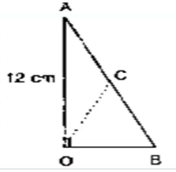In Figure, ∠ABC=690, ∠ACB=310 , find ∠BDC
To solve the problem, we need to find the angle ∠BDC given the angles ∠ABC=69∘ and ∠ACB=31∘.
1. Identify the Angles in Triangle ABC:
We know that the sum of the angles in a triangle is 180∘. Therefore, we can find ∠BAC (let's denote it as ∠A) using the formula:
∠A+∠ABC+∠ACB=180∘
Substituting the known values:
∠A+69∘+31∘=180∘
2. Calculate Angle A:
Now, simplify the equation:
∠A+100∘=180∘
Subtract 100∘ from both sides:
∠A=180∘−100∘=80∘
3. Use the Inscribed Angle Theorem:
According to the inscribed angle theorem, angles subtended by the same arc at the circumference of a circle are equal. Since ∠A and ∠D subtend the same arc BC, we have:
∠D=∠A=80∘
4. Identify Angle BDC:
We need to find ∠BDC. Since ∠BDC is also an angle subtended by the same arc BC, we can conclude:
∠BDC=∠D=80∘
Final Answer:
Thus, the value of ∠BDC is 80∘.
---
We know that the sum of the angles in a triangle is 180∘. Therefore, we can find ∠BAC (let's denote it as ∠A) using the formula:
∠A+∠ABC+∠ACB=180∘
Substituting the known values:
∠A+69∘+31∘=180∘
Now, simplify the equation:
∠A+100∘=180∘
Subtract 100∘ from both sides:
∠A=180∘−100∘=80∘
According to the inscribed angle theorem, angles subtended by the same arc at the circumference of a circle are equal. Since ∠A and ∠D subtend the same arc BC, we have:
∠D=∠A=80∘
We need to find ∠BDC. Since ∠BDC is also an angle subtended by the same arc BC, we can conclude:
∠BDC=∠D=80∘
Thus, the value of ∠BDC is 80∘.
Topper's Solved these Questions
Similar Questions
In Fig.81, side BC of ABC has been produced to D and CEBA. If ∠ABC=650, ∠BAC=550, find ∠ACE, ∠ECD and ∠ACD.
View SolutionIn Figure, PQ∣∣RS, ∠AEF=950, ∠BHS=1100 and ∠ABC=x0. Then the value of x is (a)150 (b) 250 (c) 700 (d) 350
View SolutionThe side BC of ABC is produced to a point D. The bisector of ∠A meets side BC in L. If ∠ABC=300and ∠ACD=1150, then ∠ALC= 850 (b) 72120 (c) 1450 (d) none of these
View SolutionD is a point on the side BC of ABC. A line PDQ , though D , meets side AC in P and AB produced at Q . If ∠A=800, ∠ABC=600 and ∠PDC=150 find (i) ∠AQD (ii) ∠APD.
View SolutionIn Figure, ∠AOB=900, AC=BC, OA=12 cm and OC=6.5cm. Find the area of AOB.

View SolutionABCD is a cyclic quadrilateral in which: BCAD, ∠ADC=1100 and ∠BAC=500. Find ∠DAC ∠DBC=800 and ∠BAC=400. Find ∠BCD ∠BCD=1000and ∠ABD=700 find ∠ADB
View SolutionIn a parallelogram ABCD, the diagonals bisect each other at O. If ∠ABC=300, ∠BDC=100and ∠CAB=700, Find: ∠DAB, ∠ADC, ∠BCD, ∠AOD, ∠DOC, ∠BOC, ∠AOB, ∠ACD, ∠CAB, ∠ADB
Given that
∠ABC=302,∠ABC=∠ADC=300
[We know that measure of opposite angles are equal in a parallelogram]
∠BDC=100
∠CAB=700
∠BDA=∠ADB=∠ADC–∠BDC
302–102=202
∠DAB=1800–300=1500
∠ADB=∠DBC=200 (alternate angles)
∠BCD=∠DAB=1500
[we know, opposite angles are equal in a parallelogram]
∠DBA=∠BDC=100
[we know, Alternate interior angles are equal]
InΔABC
∠CAB+∠ABC+∠BCA=1800
[since, sum of all angles of a triangle is 180^0]
700+300+∠BCA=1800
∠BCA=1800–1000=800
∠DAB=∠DAC+∠CAB=700+800=1500
∠BCD=1500 (opposite angle of the parallelogram)
∠DCA=∠CAB=700
In ΔDOC∠BDC+∠ACD+∠DOC=1800
[since, sum of all angles of a triangle is 180^0]
100+700+∠DOC=1800
∠DOC=1800−800
∠ACB=800
View SolutionIn a rhombus ABCD, if ∠ACB=40∘, then ∠ADB=(a) 70∘ (b) 45∘ (c) 50∘ (d) 60∘
View SolutionIn a ABC, ∠B=1050, ∠C=500, Find ∠A
View SolutionIn fig.41, ABC is a right triangle right angled at A. D lies on BA produced and DE⊥BC, intersecting AC at F . if ∠AFE=1300, find ∠BDE (ii) ∠BCA ∠ABC
View Solution
